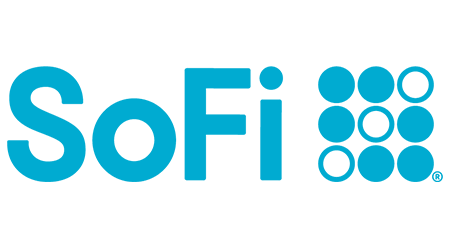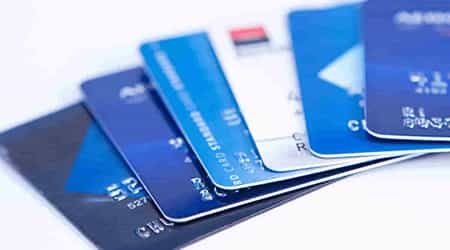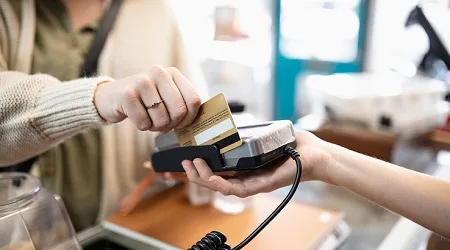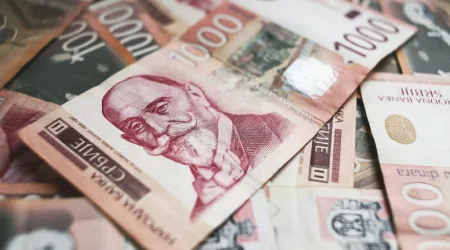Travel money guide: Serbia
A guide on using your money in Serbia
Serbia is home to mountains, monasteries, vampires (well, maybe), raspberries and an edgy nightlife scene. This Balkan nation is a growing destination for tourists, but remember your cash — especially if your wanderlust leads you to the vineyards or mountains like Fruska Gora. Serbians rely on cash more than other countries in Western Europe, using the Serbian dinar as their main payment method.
Visa and Mastercard credit cards are accepted by most hotels and shops in major cities and at ATMs. Go with a travel credit card in hand to avoid pesky foreign transaction fees. You’ll also find banking services in Belgrade and other large cities modern and safe — however, you may have problems using your cards for purchases and ATMs outside the big cities.
Our picks for traveling to Serbia

- 20,000 miles (equal to $200 in travel) after spending $500 in the first 3 months
- Earn unlimited 1.25x miles on all purchases
- Low intro rates on purchases and balance transfers
Travel card, debit card or credit card?
Most major credit cards are accepted by merchants in major cities like Belgrade. And you’ll easily find ATMs that support both credit card and debit cards. However, once you leave the big cities, be sure you have cash on hand. You won’t always find vendors that take credit.
Wait until you arrive in Serbia to exchange your USD. Exchange companies in the US charge high commissions, taking a cut of what could go a long way in Serbia. You’ll find exchanges at the airport and in the cities or in banks — all offering about the same rate.
There are no travel cards that support Serbian dinars. If you’re traveling through Europe using your travel card, be sure to find one that waives the currency conversion fee when you spend in dinars.
Pick a variety of ways to access and spend your money while you’re in Serbia so that you have options. A credit card is a convenient line of credit you can use on your vacation, while a debit or prepaid travel card is a good option when you want to make ATM withdrawals.
These are your options for spending money in Serbia
Using a credit card
Travel credit cards give you a line of credit to use for emergencies, large purchases or over-the-counter transactions. Find yourself a credit card that waives foreign transaction fees, like the Capital One VentureOne Rewards Credit Card (Terms apply, see rates & fees). Carrying a travel credit card gives you the added benefit of travel insurance and discounts, depending on your provider. For added savings, take advantage of the interest-free period by paying your balance in full each month.
Cards that offer travel perks and waive fees often charge an annual fee, so make sure the fee is worth it before you bring it along on your travels.
- Tip: It’s worth researching credit cards that offer travel benefits and rewards for things you’ll buy anyway — like flights and hotel stays.
Pros
- Rewards program and travel insurance
- Waived international ATM and conversion fees
- Interest-free days on purchases
Cons
- Fees and interest for cash withdrawal
Using a debit card
A travel debit card lets you spend your own money through ATM withdrawals and make purchases anywhere Visa or Mastercard are accepted. The Betterment Checking, for instance, keeps your pockets padded by reimbursing international foreign transaction and ATM fees. You can use a debit card over the counter and to withdraw money from ATM. Because you’re spending your own money, you avoid interest charges you’d pay with credit cards.
- Tip: Serbs have been able to make contactless payments for years. So, if your card is a CHIP card, you can tap and go at most merchants.
Pros
- Can be used at ATMs and over the counter
- Waived currency conversion fees for purchases
- Waived overseas ATM withdrawal fees
Cons
- No access to cash advance
Using a prepaid travel card
No travel cards support Serbian dinar, so look for a card that waives the currency conversion fee, such as Travelex, if you’re set on taking a travel card. It won’t apply the additional charge for currency conversion when you spend in dinar, which can be higher than what you’d pay if you use your regular debit or credit card.
The compromise is it charges you to use an international ATM withdrawal in Serbia, which is a couple of dollars for each withdrawal. You can load these cards with euros to use at some merchants— but don’t count on it. And you won’t get the best exchange rate. The benefit of a prepaid card is that they let you lock in the exchange rate when you load your funds. However, they often don’t charge as competitive exchange rates as credit cards and debit cards.
- Tip: When you get a travel card, you’ll get two for the same account. This comes in handy if your first card is lost or stolen, so make sure to keep the second card in a safe place.
Pros
- Lock in exchange rates
- Convenient to spend money overseas
- Additional cards available
Cons
- Doesn’t hold Serbian dinars
- Comes with lots of fees for loading and reloading, inactivity and ATM withdrawals
- Exchange rates are lower than credit cards and debit cards
Paying with cash in Serbia
Once you arrive in Serbia, look for a bank or exchange office to exchange your dollars for dinar. There are also money exchange machines that are open 24 hours a day. They take euros, sounds and US dollars and exchange up to $200 at a time. Though travel, debit and credit cards are accepted in the cities, you’ll likely need cash if you’re shopping at smaller vendors or markets. You will need dinars in Serbia; petrol stations near the borders may take euros at an unfavorable exchange rate.
- Tip: Avoid carrying large amounts of cash, as tourists are often the target of criminals, especially in big cities.
- ATMs are common throughout the cities, though availability can be a problem in villages. The local post office may be able to give you a cash advance if you find yourself in an area lacking ATM and banking facilities. Bank ATMs do not charge a local ATM operator fee.
Pros
- Accepted anywhere
- Convenient
Cons
- More difficult to manage expenses
- High risk of theft
Using traveler’s checks
If you bring traveler’s checks, you can cash American Express and Visa issued checks at most banks. Though, don’t try to use them in stores as they won’t accept them. Traveler’s checks have been replaced by credit cards and travel cards.
Pros
- Accepted at most banks
- Security
Cons
- Fees for purchasing and cashing
- Hard to find merchants that accept them
Exchange rate history
The USD has grown significantly against the RSD in the past 10 years. Watch the forex markets and determine a good time to buy dinars and lock in a favorable rate with traveler’s checks.
Live Rate
Refreshing in: 60s | Wed, May 01, 11:28PM GMT
Buying dinars in the US
Your options are limited if you want to purchase dinars in the US — wait until you arrive in Serbia. Because dinar is considered an exotic currency, it can be hard to find in the US, and the rates and commission is higher than in Serbia.
Serbian currency
The official currency in Serbia is the Serbian Dinar RSD and comes in denominations of 10, 20, 50, 100, 200, 500, 1000 and 5000 dinars, each a different color. Be sure to pay the right amount when you make your purchases, and always count your change. Familiarize yourself with what the currency looks like and how it works will avoid confusion when handling your money.
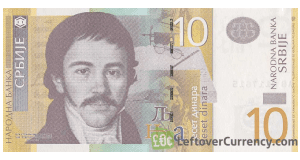 | 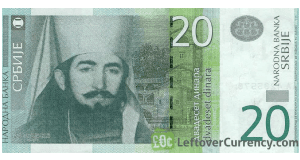 | 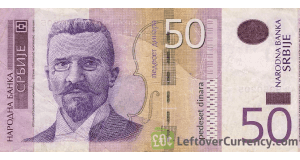 |
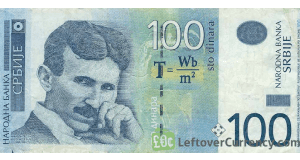 | 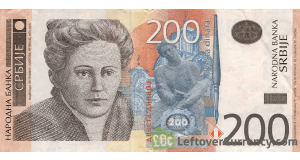 |
The main banks in Serbia are:
- Banca Intesa – Beograd
- Komercijalna Banka
- UniCredit Banka Serbia
- Societe Generale Banka Serbia
- Raiffeisen Banka
- AIK Banka
- Eurobank
- Erste Bank Serbia
- Banka Postanska Stedionica
- Vojvodanska Banka
ATMS in Serbia
You can easily find ATMs in Belgrade and at the airport as well as in local post offices. However, the further you go toward the mountains and rural areas, the less you’ll find ATMs at your convenience. When stashing up on cash before exploring the country, go with a Betterment Checking account and debit card to get those pesky international ATM fees reimbursed within 24 hours.
Cash pickup services in Serbia
How much dinars do I need to bring to Serbia?
Travel to Serbia and the Balkans is cheaper than most countries in Western Europe. Budget travelers can find food, entertainment and a dorm bed for under $15 a day. Mid-range travelers can travel for under $30 a day, and luxury travelers can live it up for under $80 a day. All prices are in US dollars.
| Belgrade | Budget | Mid-range | Expensive |
|---|---|---|---|
| Accommodation | Hostel dorm bed: $4–$10 per night | 3-star hotel: $10 per night | 5-star hotel: $20–$50 per night |
| Meals | Lunch at a small Serbian grill: $3–$6 per item | Lunch at a pizza & pasta restaurant in the city: $5–$10 per dish | Fine dining. 5-star restaurant: $15–$20 per main |
| Activities | Downtown Belgrade walking tour: Free | Section 1 seats for the opera at the Serbian National Theatre, Belgrade: $15 | Private guided food tour: $150 per person |
Prices are approximate and are subject to change.
Case study: Victor and Salome’s travel tips to Serbia
Victor and Salome went to Serbia’s famous EXIT electronic music festival in the Petrovaradin Fortress, Novi Sad, near Belgrade. They’d just come from Hungary and the festival was only a short stop on a longer trip through Europe. They arrived in Belgrade and took a train to Novi Sad. We interviewed them to see what experiences they had using travel money while in Serbia.
Do you have any tips?
Have a look at the Belgrade Pass. It gives you discounts on admission to museums, discounts on dinner at selected restaurants, hotels, hostels, car rental and a comprehensive city guide for $15, says Victor. Salome adds that you should always tell your bank when you’re leaving the country. Otherwise, they may block your cards if they see an overseas transaction.
More guides on Finder
-
Travel money guide: USA
How to pay, how much to bring and travel money suggestions for your trip to USA.
-
Travel money guide: South Africa
How to pay, how much to bring and travel money suggestions for your trip to South Africa.
-
Travel money guide: Sri Lanka
How to pay, how much to bring and travel money suggestions for your trip to Sri Lanka.
-
Travel money guide: Mexico
How to pay, how much to bring and travel money suggestions for your trip to Mexico.
-
Travel money guide: Portugal
How to pay, how much to bring and travel money suggestions for your trip to Portugal.
-
Travel money guide: Hungary
How to pay, how much to bring and travel money suggestions for your trip to Hungary.
-
Travel money guide: Ecuador
How to pay, how much to bring and travel money suggestions for your trip to Ecuador.
-
Travel money guide: Fiji
How to pay, how much to bring and travel money suggestions for your trip to Fiji.
-
Travel money guide: Japan
How to pay, how much to bring and travel money suggestions for your trip to Japan.
-
Travel money guide: South America
How to pay, how much to bring and travel money suggestions for your trip to South America.
Ask a Question

